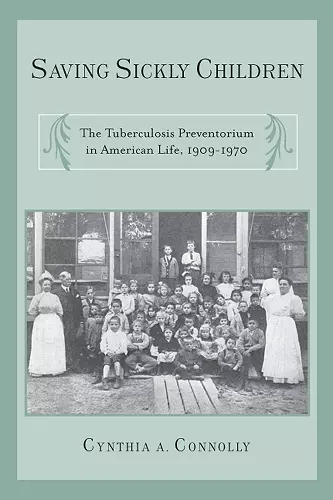Saving Sickly Children
The Tuberculosis Preventorium in American Life, 1909-1970
Format:Paperback
Publisher:Rutgers University Press
Published:14th Mar '14
Currently unavailable, and unfortunately no date known when it will be back

Known as "The Great Killer" and "The White Plague," few diseases influenced American life as much as tuberculosis. Sufferers migrated to mountain or desert climates believed to ameliorate symptoms. Architects designed homes with sleeping porches and verandas so sufferers could spend time in the open air. The disease even developed its own consumer culture complete with invalid beds, spittoons, sputum collection devices, and disinfectants. The "preventorium," an institution designed to protect children from the ravages of the disease, emerged in this era of Progressive ideals in public health.
In this book, Cynthia A. Connolly provides a provocative analysis of public health and family welfare through the lens of the tuberculosis preventorium. This unique facility was intended to prevent TB in indigent children from families labeled irresponsible or at risk for developing the disease. Yet, it also held deeply rooted assumptions about class, race, and ethnicity. Connolly goes further to explain how the child-saving themes embedded in the preventorium movement continue to shape children's health care delivery and family policy in the United States.
"[A] carefully researched and informative history. The tale is one of good intentions, money, fear, and social class, and Connolly provides an excllent overview not only of preventoriums but also of how the preventorium movement evolved naturally as an outgrowth of the ideals of the Progressive Era." * New England Journal of Medicine *
"Superbly researched and elegantly written, Saving Sickly Children is a a wonderful contribution to the history of tuberculosis and American society." -- Howard Markel, M.D., Ph.D. * author of When Germs Travel and Quarantine! *
"In this evocative and engaging history, Cynthia Connolly brings alive American doctors, nurses, patrons and children and their families as they struggled to shape clinical and public policies around children considered 'at risk' of the White Plague. Written with a sparkling clarity and a wise eye to current clinical and health policy debates, this book brings together medical, family and welfare history in ways that will linger with every reader." -- Naomi Rogers * Yale University *
"...a fascinating book. Interspersed with the story of the preventoria is a history of tuberculosis control and treatment in the first half of the 20th century. Saving Sickly Children is a treat to read." -- Abraham Bergman * Archives of Pediatrics & Adolescent Medicine *
"Connolly has produced a study of interest to both historians and health professionals." * Social History of Medicine *
"Informative and solidly researched. The focus on prevention of pediatric tuberculosis, and on an institution far less studied than the TB sanatorium, makes this book a welcome addition to the historiography of tuberculosis. The author's engagement in current debates on children's health makes the sound historical analysis also highly relevant for today's concern in preventive and public health." * Medical History *
"Connolly draws on her sophisticated understanding of the health care system to ask important questions. She makes a unique contribution to the history of medicine, nursing, tuberculosis, child health, and social welfare." -- Emily Abel * author of Tuberculosis and the Politics of Exclusion: A History of Public Healt *
"[A] carefully researched and informative history. The tale is one of good intentions, money, fear, and social class, and Connolly provides an excllent overview not only of preventoriums but also of how the preventorium movement evolved naturally as an outgrowth of the ideals of the Progressive Era." * New England Journal of Medicine *
"Superbly researched and elegantly written, Saving Sickly Children is a a wonderful contribution to the history of tuberculosis and American society." -- Howard Markel, M.D., Ph.D. * author of When Germs Travel and Quarantine! *
"In this evocative and engaging history, Cynthia Connolly brings alive American doctors, nurses, patrons and children and their families as they struggled to shape clinical and public policies around children considered 'at risk' of the White Plague. Written with a sparkling clarity and a wise eye to current clinical and health policy debates, this book brings together medical, family and welfare history in ways that will linger with every reader." -- Naomi Rogers * Yale University *
"...a fascinating book. Interspersed with the story of the preventoria is a history of tuberculosis control and treatment in the first half of the 20th century. Saving Sickly Children is a treat to read." -- Abraham Bergman * Archives of Pediatrics & Adolescent Medicine *
"Connolly has produced a study of interest to both historians and health professionals." * Social History of Medicine *
"Informative and solidly researched. The focus on prevention of pediatric tuberculosis, and on an institution far less studied than the TB sanatorium, makes this book a welcome addition to the historiography of tuberculosis. The author's engagement in current debates on children's health makes the sound historical analysis also highly relevant for today's concern in preventive and public health." * Medical History *
"Connolly draws on her sophisticated understanding of the health care system to ask important questions. She makes a unique contribution to the history of medicine, nursing, tuberculosis, child health, and social welfare." -- Emily Abel * author of Tuberculosis and the Politics of Exclusion: A History of Public Healt *
ISBN: 9780813569673
Dimensions: 229mm x 152mm x 15mm
Weight: 454g
200 pages
First Paperback Edition